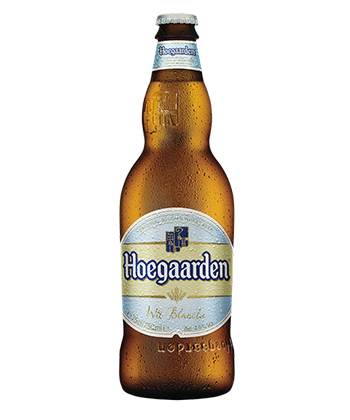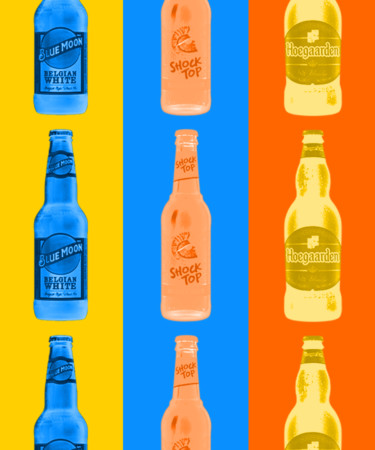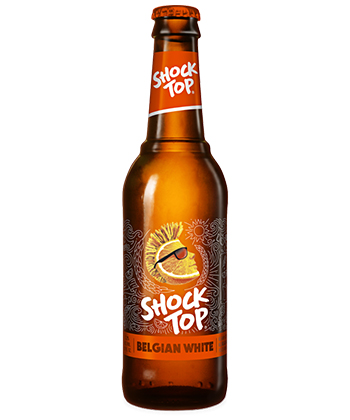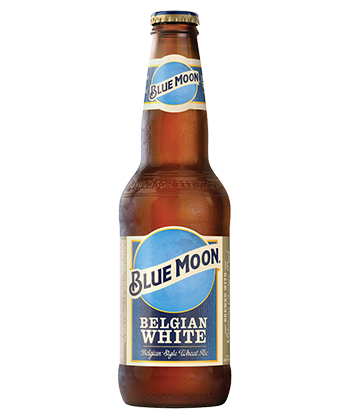While there is no shortage of unfiltered beers with citrus notes, the trifecta of Hoegaarden, Blue Moon, and Shock Top remain top choices vying for summertime drinking needs. Appealing to a wide swath of palates, all three brews have graced beer gardens for decades.
Blue Moon’s Belgian White, considered by some to be one of the most important American beers of all time, is instantly recognizable in bars due to the automatic inclusion of an orange slice in the glass. Along with top competitor Shock Top, they represent a category of beers inspired by traditional Belgian whites like Hoegaarden. But while all three beers share similar characteristics, there’s plenty that sets them apart. Keep reading to learn the differences between Blue Moon, Shock Top, and Hoegaarden.
Origin
Hoegaarden’s story begins around 1445 in the small Belgium town of the same name, where monks are believed to have fashioned the first white (“wit”) beer recipe using exotic botanicals imported by Dutch traders. Centuries later, Hoegaarden’s reign as a brewing mecca would come to an end, when Tomsin, the last remaining witbier brewery in the village, closed in 1957. However, the historic style was brought back to life in 1965 by milkman (and former Tomsin employee) Pierre Celis, who recreated the beer in his milk shed and later named it after his hometown, Hoegaarden.

Decades later, Blue Moon was founded in 1995 by brewmaster Keith Villa, who started the company’s first iteration while working at Denver’s Sandlot Brewery. Originally named Bellyslide Wit, Villa’s creation was an ode to Belgian witbiers, a style he became fond of while working toward a Ph.D. in brewing from the University of Brussels. Adding a unique twist that Villa believed would appeal to American consumers, he brewed the beer with Valencia orange peels, resulting in a slightly sweeter product than the more traditional tart Belgian whites.
Also brewed in Colorado, and perhaps with an eye toward Blue Moon’s burgeoning success, Anheuser-Busch’s Shock Top was released in 2006 as a seasonal offering. Originally dubbed Spring Heat Spiced Wheat, the ale became a regular offering for the mega brand after it won top accolades at the North American Beer Awards in 2006 and 2007.
Production
In addition to incorporating Curaçao orange peel and coriander, Hoegaarden White is made with malted barley, unmalted wheat, and hops. During production the beer undergoes bottle-conditioning — the addition of a small amount of yeast to an already fermented beer — that yields a small amount of natural carbonation and yeast sediment. To enhance its flavors, the company suggests pouring two-thirds of the beer into a glass, swirling the remaining liquid in the bottle before pouring the remainder into the glass.
While there are limited details about how Blue Moon Belgian White is made, Diffords Guide lists its ingredients as “white wheat, oats and malted barley with hops, coriander and orange peel.” Compared to Hoegaarden, it has a slightly elevated alcohol content and is brewed with Valencia orange rather than the more traditional Curaçao orange. Shock Top’s flagship Belgian White is made with two-row barley and a blend of Hallertau, Cascade, and Willamette hops that are then brewed with three different citrus peels — orange, lemon, and lime.
Flavor
At 4.9 percent ABV, Hoegaarden is a bit lower in alcohol for its style. Pale in color, cloudy, and light-bodied, the beer has citrus and pepper on the nose, with a crisp and refreshing bitterness on the palate and a lightly spiced finish. Blue Moon, which comes in at 5.4 percent ABV, is also light-bodied and hazy but offers a fresh-squeezed orange profile with hints of coriander. Medium-bodied and unfiltered, Shock Top is bottled at 5.2 percent, with mellow lime, coriander, and orange flavors.
What the Pros Think
Each brand has its die-hard fans, but for many beer aficionados, Hoegaarden represents a benchmark of the witbier style. Jillian Bernat, the beverage director at Greenleaf in Milford, N.H., sums up the difference between the three: “Blue Moon and Shock Top are Belgian style. Hoegaarden is a true Belgian white.” And while Hoegaarden gets her vote due to its quality and “true roots,” she credits Shock Top and Blue Moon as being “great beers [that] already have their own following in a pub setting.” For Bernat, Hoegaarden’s history makes the difference, adding: “We love unique selections that have a good story. It’s all about the stories.”


